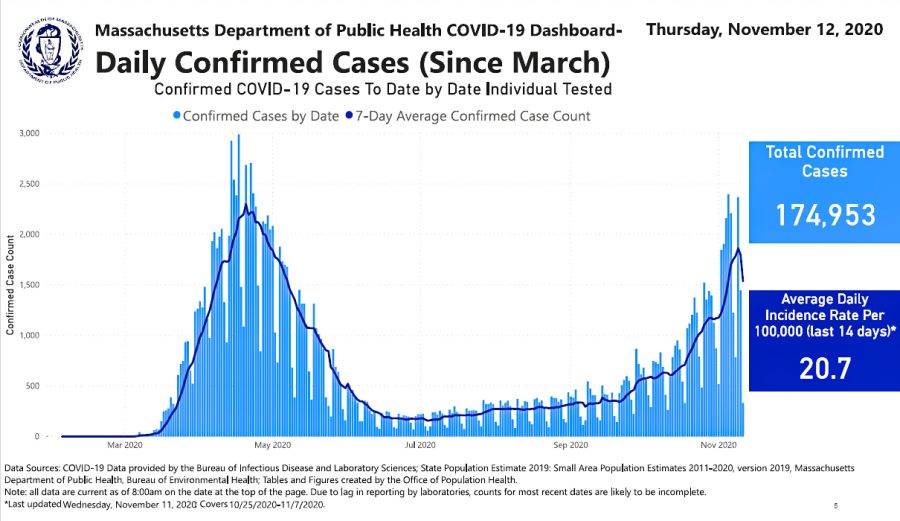Gov. Baker issued new COVID-19 restrictions and updated the risk-categories for each city and town, amid upticks in COVID-19 cases across the state and the country.
Recently, daily COVID-19 cases in Massachusetts have hit the highs experienced in April, during the first wave of the pandemic.
On Wednesday, Nov. 11, Massachusetts reported 2,495 cases. The seven-day average of positive tests reached 2.63 percent in the state. In Boston, the seven-day positivity moving average on November 1 reached 7.1 percent.
In the U.S., new COVID-19 cases reached record highs for seven days in a row. On Tuesday, Nov. 10, at least 134,000 cases were reported.
A stay at home order between 10 p.m. and 5 a.m. began on Friday, with exceptions to those traveling to or from work.
Effective Nov. 6 at 12:01 a.m., Baker ordered various businesses to close at 9:30 p.m., such as gyms, movie theaters, restaurants, and other venues. However, restaurants are allowed to offer take-out and delivery (excluding alcohol) during the closing period.
Outdoor gatherings are limited to 25 people and indoor gatherings limited to only 10. With the cold weather approaching, residents are inclined to hold gatherings indoors. Such events are a driving cause of recent cases.
2,945 clusters were identified between Sept. 27 and Oct. 24, causing 8,208 confirmed cases. The majority of these occurred in households. 3,600 clusters were also found between Oct. 4 and 31, linked to 10,239 cases.
Face masks are now required for everyone over the age of five in all public places, with the exception of those with medical conditions.
Gov. Baker also changed the COVID-19 dashboard.
Population size is now taken into account when determining categories. Large communities with more than 50,000 residents with more than 10 cases per 100,000 people, along with a positive rate of more than 4 percent, will be considered high-risk. Communities with less than 10,000 residents will be designated as red when they have more than 25 cases. Those in between 10,000 and 50,000 residents will need more than 10 cases per 100,000 people and a 5-plus percent positivity rate to be considered high-risk.
The new system significantly reduced the number of high-risk cities, decreasing the number from 121 to 16. The high-risk cities are now Brockton, Chelsea, Everett, Fall River, Lawrence, Lowell, Lynn, Methuen, New Bedford, Norfolk, Revere, Seekonk, Somerset, Springfield, and Westport.
State officials are expecting areas considered gray, green, and yellow to resume in-person classes, and encourage those in the red category to consider a hybrid model of education. Baker says that children are “at less risk of getting it” and in-person classes “do not lead to a higher transmission rate” as long as restrictions are followed.
In regards to travel, the Massachusetts Department of Public Health recently removed California from its lower-risk locations list. Travelers not coming from Hawaii, Maine, New Hampshire, New York, Vermont, Washington, and Washington D.C are required to fill out a travel form and conduct a two-week quarantine or produce a negative COVID-19 test.
The Department of Public Health also removed Connecticut and New Jersey from the low-risk list. This decision came after Connecticut added Massachusetts to their travel advisory list and New York required quarantine or a negative test for visitors from Massachusetts.
Although hospitalizations are already increasing, the state is preparing by adding field hospitals.
Baker said field hospitals will be set up based on “available space and where the needs are.” They will be equipped with hospital beds, medical supplies, and equipment, according to Baker.
Thanksgiving is approaching; celebrations and gatherings could potentially lead to higher cases and transmission to the vulnerable.
Baker acknowledges “COVID fatigue,” but urges the public to stick to restrictions, as the virus is “merciless” and “will continue to grow and spread whenever it’s given the opportunity.”

